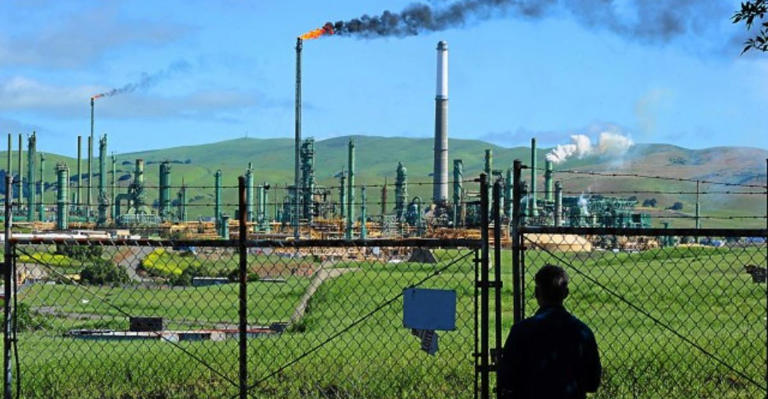
California Faces $6 Gas Again—Oil Giant Valero Shuts Down Refinery After Record $82 Million Fine
Story by Mary Jones
A pivotal shift is underway in California’s energy landscape. By spring 2026, Valero will close its Benicia refinery, cutting off 145,000 barrels of gasoline and diesel daily—about 8% of the state’s refining capacity. This abrupt loss, totaling 2.2 billion gallons annually, threatens to reshape fuel availability and pricing for millions of drivers and businesses across Northern California, a region already burdened with the highest gas prices in the continental United States.
Economic Anchor Unravels
For decades, the Valero Benicia refinery has been a cornerstone of the local economy and a vital link in California’s fuel supply chain. Hundreds of employees and thousands of contractors depend on its operations, while its strategic location ensures steady fuel distribution to gas stations, airports, and trucking fleets. The shutdown’s impact will ripple far beyond personal vehicles, affecting shipping routes, aviation, and emergency services. “This is distressing and a major blow,” said Benicia Mayor Steve Young, reflecting widespread local concern over the loss of jobs and revenue.
The city stands to lose $11 million annually in property taxes, jeopardizing funding for schools, emergency services, and municipal operations. The economic fallout extends to state tax revenues and threatens to undermine public resources that residents rely on daily.
Rising Prices and Market Volatility
Analysts warn that removing Benicia’s refining capacity could add up to 15 cents per gallon for consumers even before the shutdown, as markets react in advance. In supply crunch scenarios, state projections suggest prices could spike above $7 or $8 per gallon. California drivers, already paying $1–$2 more than the national average, may face new record highs as supply tightens and seasonal demand surges.
Fuel-dependent industries—truckers, farmers, airlines—are bracing for higher operating costs, which could cascade into consumer prices for groceries, travel, and more. “We expect Northern California premiums to climb ahead of the 2026 shutdown,” said Tom Kloza, global head of energy analysis at Oil Price Information Service.
Regulatory Pressures and Failed Solutions
Valero’s decision stems from escalating costs tied to California’s stringent environmental regulations, legal disputes, and compliance upgrades. Company executives describe the regulatory environment as “structurally unworkable,” noting that negotiations with state officials failed to yield solutions. “Nothing has materialized to keep Benicia operational,” a Valero spokesperson confirmed, underscoring that costs now outweigh the benefits—even for a global industry leader.
State officials held urgent talks to prevent the closure, but emissions mandates and permitting barriers proved insurmountable. With the shutdown timeline now under six months, attention has shifted from prevention to damage control. Governor Gavin Newsom and lawmakers are reviewing emergency measures, including infrastructure upgrades and strategic fuel reserves, but acknowledge that such efforts may not arrive in time to avert near-term consequences.
A Green Paradox and Global Comparisons
California’s push for electrification and climate commitments has not kept pace with consumer transition. The state’s 27 million licensed drivers still rely heavily on gasoline, and the loss of Benicia’s output will significantly tighten availability, especially during peak travel seasons. “We’re eliminating refineries faster than consumers are switching to electric vehicles,” said Severin Borenstein, energy economist at UC Berkeley. This deepens a paradox: the drive for a cleaner future is colliding with persistent fuel demand.
Globally, California’s predicament mirrors trends in other regions with aggressive climate policies. In Europe, refinery closures have increased reliance on imports, exposing markets to international price shocks and supply disruptions. California’s unique fuel standards and pipeline limitations mean replacement barrels must come from overseas—primarily Asia and the Middle East—at higher costs and longer transit times. “A refinery shutdown in California isn’t replaced by a refinery in Texas; it’s replaced by a tanker crossing the Pacific,” Borenstein explained.
Human and Community Impact
The closure places hundreds of refinery workers and thousands of indirect jobs at risk. Valero has pledged to explore support options, but families are bracing for layoffs that could redefine the community. Local leaders and residents fear a chain reaction: reduced business activity, falling home prices, and diminished investment. Industrial towns across the U.S. have shown the lasting effects when a major employer disappears, and Benicia now faces similar uncertainty.
Looking Ahead: California at a Crossroads
As the countdown to Benicia’s shutdown accelerates, California faces critical decisions about its energy and economic future. Can the state ramp up electric vehicle adoption quickly enough to offset shrinking fuel supplies? Will businesses withstand rising energy costs, or will more operators follow Valero’s exit? Regulators must act swiftly to prevent further refinery closures and manage the risks of growing import dependency.
The stakes stretch far beyond one facility. The Benicia closure is a direct test of California’s current strategy, with implications for national energy policy and the future of transportation. As gasoline demand remains high and refining capacity dwindles, millions of Californians are left to navigate a more volatile, uncertain fuel market—one shaped by local decisions and global forces alike.

Comments (0)